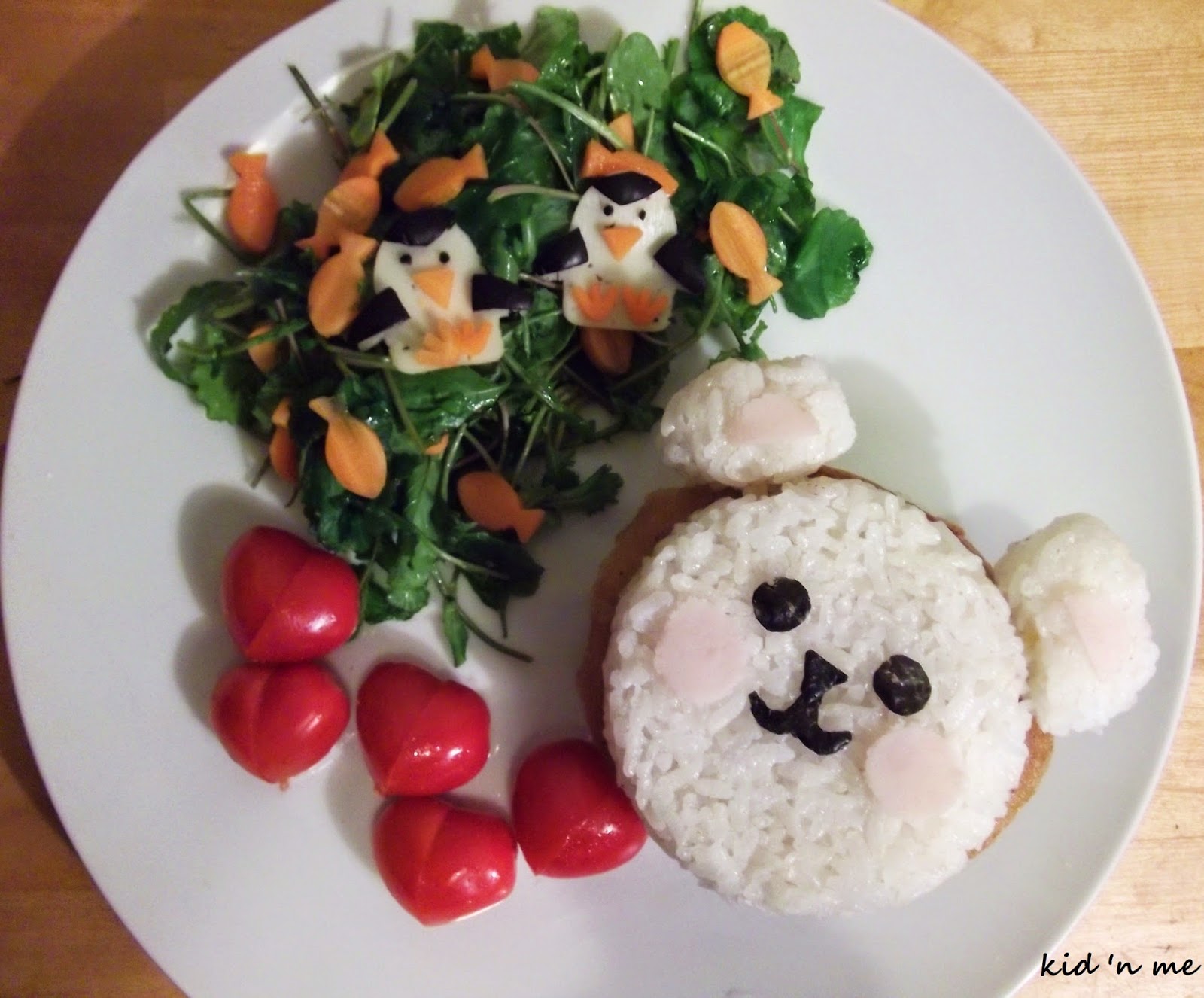Ciao a tutti,
eccoci qui con il nostro Funny Food Friday e … un pranzo/una
cena polare!
Ho preparato questa cene questa settimana, anche se ormai è
primavera e la temperatura fuori è sempre più calda.
Avevo in casa degli hamburger di pesce e volevo cucinarli,
ma non avevo pane. E poi, anche se è strano, a mio figlio non piacciono
particolarmente gli hamburger, anche se li mangia.
Ingredienti:
-hamburger di pesce o di carne
-riso cotto al vapore
-alga nora in fogli
-prosciutto cotto
-insalata
-formaggio a fette
-olive nere
-carota
-pomodorini
Per prima cosa ho preparato il riso al vapore. Quando era
pronto ho fatto 2 hamburger di riso rotondi e spessi 1 cm, della misura
perfetta per un hamburger. Li ho fatti con un misurino che ho in casa che è
proprio di quelle misure. Poi ho spennellato della salsa di soia su 2 lati di
un hamburger e su un lato solo dell’altro.
Mentre ho messo a cuocere hamburger di pesce ho messo in un’altra
padella gli hamburger di riso con la loro soia. Uno l’ho cotto su due lati, l’altro
non l’ho cotto dalla parte dove non c’era la soia perché lo volevo bianco.
Intanto ho tagliato l’alga nori in naso, bocca e occhi di un
orso e ho tagliato tre piccoli cerchi di prosciutto. Due li ho lasciati interi
e uno l’ho tagliato a metà in modo da avere sue semicerchi.
Ho tagliato un paio di pinguini di formaggio con un
tagliabiscotti e con due formine più piccolo ho tagliato dalla carota le zampe
e I becchi del pinguino. Poi ho tagliato le olive nere in modo da creare occhi,
pinne e testa dei pinguini.
Poi ho tagliato la carota a fette e con una piccola formina
ho tagliato tanti pesciolini.
Poi ho tagliato i pomodori datterini a metà in diagonale, ho
girato una delle due parti creando dei cuori, che in realtà non hanno nulla a
che fare con il Polo, comunque … Erano
carini J
Quando gli hamburger erano pronto ho messo sul piatto l’hamburger
di riso e salsa di soia, quello di pesce e sopra l’altro di riso con la parte Bianca
rivolta verso l’alto. Ho aggiunto naso bocca e occhi di alga nori e i due
cerchietti di prosciutto per le guance.
Poi ho fatto due palline di riso e le ho attaccate alla
testa dell’orso con due pezzettini di spaghetti crudi, poi ci ho messo sopra i
semicerchi di prosciutto e così ho creato le orecchie dell’orso polare.
 HO messo un po’ di insalata sul piatto, e sopra di essa i
pesciolini di carota e poi i due pinguini di formaggio.
HO messo un po’ di insalata sul piatto, e sopra di essa i
pesciolini di carota e poi i due pinguini di formaggio.
Alla fine ho messo anche i cuori di pomodoro.
E voilà!
Abbastanza veloce e facile J
E il pargolo era super contento e se l’è gustato molto!
Spero lo proviate anche voi.
A presto,
ciaociao
Hi
everyone,
here we are
again with our Funny Food Friday and a … polar lunch/dinner!
I made this
dinner this week, even though it’s spring and the temperature outside is getting
warm.
I had this
fish burger that I wanted to cook, but no bread available. And, strange enough,
burgers are not the kid favorite food, even though he eats them.
So I thought
to characterize it a bit to make it fun.
Ingredients:
-fish or
meat burger
-steamed
rice
-ham
-salad
-cheese
slice
-black
olives
-carrot
-tomatoes
First I made
the Japanese steamed rice. When ready I made 2 rice burgers 1 cm thick with a
measuring cup that I have that is round and 1cm thick, the perfect size to make
a rice hamburger. Then I coated with soy sauce both sides of 1 of the burgers,
and I covered in soy sauce only 1 side of the burger left.
While I started
cooking the fish burger I put in another pan the 2 rice burgers to cook a bit
with their soy sauce. I only didn’t cooked the white side of one burger ‘cause I
wanted it to keep white.
Meanwhile I
cut the nose, the eyes and the mouth of a bear from nori sheet and cut 3 ham
circles. I kept 2 circle round and I cut 1 in half to have two semicircles.
I cut with
a cookie cutter a couple of penguins out of cheese slice and with two other
small cookie cutters I made the feet and the beaks of the penguin out of
carrot. Then cut black olives to make the eyes, the head fur and the flippers.
Then I sliced
a carrot and with a mini cookie cutter I cut small fishes.
Then I cut
the tomatoes in half diagonally, twisted one part and created some hearts, that
actually have nothing to do with the Pole, but still… They
were cute J
When the burgers
were done I put on the plate the rice burger covered in soy sauce, the fish
burger and the other rice burger with the white side on top. I added the nori
nose, mouth and eyes and the two ham circles for the cheeks.
Then I made
two small little balls of rice and stuck them on the bear head using two small
raw spaghetti pieces and placed the ham semicircles on them to create the ears
of the polar bear.
I put some
salad on the plate and the carrot fishes on it, then I placed on it also the cheese penguins.
In the end I
put the tomato hearts.
Quite fast
and easy J
And the kid
was super happy and enjoyed it a lot!
Hope you’ll
try to make it.
See you
soon
ciaociao













































